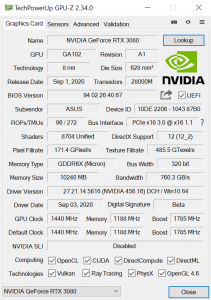
For our fourth RTX 3080 review, our attention turns to ASUS and one of its custom designs. Rather than a look at the ASUS ROG Strix model, however, the card in for review today is the TUF Gaming RTX 3080 OC. While not as premium an offering as the upcoming ROG Strix card, the TUF 3080 still sports an all-aluminium shroud, on-board dual-BIOS functionality as well as a factory overclocked core. With an MSRP of £689, it's certainly ticking a lot of boxes on paper, but just how good is it?
First of all, we are clearly aware that finding stock of any RTX 3080 is difficult at the moment, and pre-order prices seem to have been increased over the MSRPs at several retailers. That can make an objective review tricky, but ASUS has explicitly told us the MSRP for the TUF Gaming RTX 3080 OC is £689, so that is the price we will use throughout this review. We don't know when cards will actually be in stock to buy at that price, but at least two retailers we have seen (Currys and AWD-IT) are using the MSRP price for their listings, the cards are just not available.
We contacted ASUS UK about the supply issues and were sent the follow statement, copied verbatim:
“ASUS is delighted to see the interest in their new RTX 30 series range and hopes that all who were able to purchase a card enjoy their next generation of ASUS and ROG gaming power. Demand for this stock is high and we will be replenishing stock with our retail partners as soon as possible. Please make sure your pre-order is made with your chosen retailer who will update you when stock will be available.”
Aside from the supply troubles, it's also worth making clear we are reviewing the TUF Gaming RTX 3080 OC edition (TUF-RTX3080-O10G-GAMING), when there is also a non-OC edition (TUF-RTX3080-10G-GAMING) which has an MSRP of £649. The only difference appears to be the clock frequency, as the OC edition – obviously – comes factory overclocked.
| GPU | RTX 3090 | RTX 3080 | RTX 2080 Ti (FE) | RTX 2080 SUPER | RTX 2080 (FE) |
| SMs | 82 | 68 | 68 | 48 | 46 |
| CUDA Cores | 10496 | 8704 | 4352 | 3072 | 2944 |
| Tensor Cores | 328 | 272 | 544 | 384 | 368 |
| RT Cores | 82 | 68 | 68 | 48 | 46 |
| Texture Units | 328 | 272 | 272 | 192 | 184 |
| ROPs | 112 | 96 | 88 | 64 | 64 |
| GPU Boost Clock | 1695 MHz | 1710 MHz | 1635 MHz | 1815 MHz | 1800 MHz |
| Memory Data Rate | 19.5 Gbps | 19 Gbps | 14 Gbps | 15.5 Gbps | 14 Gbps |
| Total Video Memory | 24GB GDDR6X | 10GB GDDR6X | 11GB GDDR6 | 8GB GDDR6 | 8GB GDDR6 |
| Memory Interface | 384-bit | 320-bit | 352-bit | 256-bit | 256-bit |
| Memory Bandwidth | 936 GB/Sec | 760 GB/Sec | 616 GB/sec | 496.1 GB/sec | 448 GB/sec |
| TGP | 350W | 320W | 260W | 250W | 225W |
Just before diving into the details, it’s worth reminding ourselves of the key specs for the RTX 3080. Built on Nvidia’s GA102 GPU, fabricated on Samsung’s 8nm process, RTX 3080 houses 8704 CUDA cores, 68 RT Cores and 272 Tensor cores.
A reference board would come clocked at 1710MHz, but as we are reviewing the TUF Gaming OC edition, this model has a rated boost clock of 1785MHz. We would still expect GPU Boost to bring actual frequency well above those levels, but we will look at that later in the review.
The 10GB VRAM is provided thanks to Micron’s new GDDR6X memory. Operating at 19Gbps, over a 320-bit bus this gives total memory bandwidth of 760GB/s.
All of those cores, fast memory and factory overclock come at a cost, however, and that is power draw. Reference TGP for a RTX 3080 is 320W, but ASUS has bumped this up to 340W, making it one of the most power-hungry GPUs I have ever tested.
Be sure to check out our sponsors store EKWB here
 KitGuru KitGuru.net – Tech News | Hardware News | Hardware Reviews | IOS | Mobile | Gaming | Graphics Cards
KitGuru KitGuru.net – Tech News | Hardware News | Hardware Reviews | IOS | Mobile | Gaming | Graphics Cards



